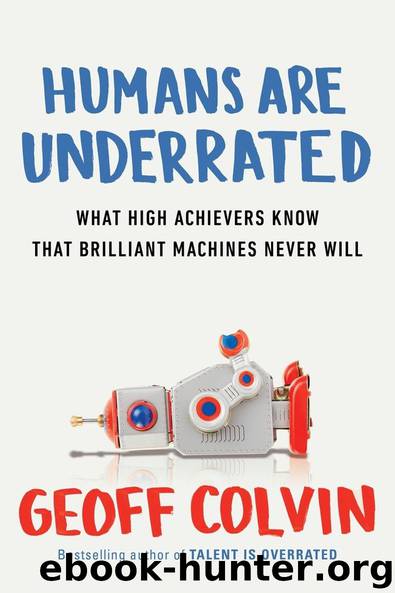Humans Are Underrated: What High Achievers Know That Brilliant Machines Never Will by Geoff Colvin

Author:Geoff Colvin [Colvin, Geoff]
Language: eng
Format: epub
Publisher: Penguin Publishing Group
Published: 2015-08-03T22:00:00+00:00
WHAT TEAMS LOSE WHEN THEY GO ONLINE
Which leads to a seemingly obvious conclusion: If lots of interaction and broad engagement are the most powerful drivers of a group’s performance, then hasn’t technology brought us to the doorway of nirvana? Aren’t e-mail, texting, and social media the greatest gift to groups in history? The answer is no, or at least not necessarily. Social interaction is the very essence of being human, as we’ve seen—a phenomenon so highly evolved that we’re still discovering all the ways in which it happens, sometimes affecting us deeply without our even realizing what happened. We didn’t develop these wondrous abilities in the electronic age, and a lot of them just don’t work online. For example, Pentland’s lab experimented with groups connected only by technology and found that members continued to use body language, even though no one could see them, and of course we’ve all done the same thing. The trouble is that we’re throwing away one of our strongest and most deeply-rooted tools for connecting with one another: mimicking. As we saw in chapter 3, we often mimic the postures and gestures of others, mostly unconsciously, and this process is extremely powerful in building empathy and trust between people, though neither party may realize it’s happening. Even when we can’t see each other, we can scarcely stop ourselves from trying to make it happen. But if we can’t see each other in real time, it won’t work.
Evidence is clear that face-to-face interaction is far richer and more effective than is the fragile, meager digital version in building trust, cooperation, and the patterns of behavior that make groups effective. Is anyone surprised? We humans were interacting face-to-face long before we developed language, and today even when we’re talking, it isn’t what we say that matters most. After badging hundreds of groups in face-to-face interaction and collecting billions of data points, Pentland and his colleagues realized that unspoken social signals—who’s talking, how much, in what tone, interrupting or not, facing toward whom and away from whom, gesturing how—told them all they needed to know about the performance of a group. They didn’t need to hear any words. Pentland’s striking finding is that “usually we can completely ignore the content of discussions and use only the visible social signals to predict the outcome of a negotiation or a sales pitch, the quality of group decision making, and the roles people assume within the group.” But most of those visible social signals aren’t available in digital communication.
When digital interaction is effective, it’s most likely between people who already have a face-to-face relationship. Some 61 million U.S. Facebook users got a “go vote” message on election day 2010, part of an experiment by political science professor James Fowler and Facebook researchers. A simple informational message about voting had no effect at all; people who got it were no likelier to vote than were those who got no message. But other users received the same message plus randomly selected profile photos of up to six of their Facebook friends who had clicked an “I voted” button on Facebook.
Download
This site does not store any files on its server. We only index and link to content provided by other sites. Please contact the content providers to delete copyright contents if any and email us, we'll remove relevant links or contents immediately.
| Business School Guides | GMAT |
| Guides | Interviewing |
| Job Hunting | Job Markets & Advice |
| Resumes | Vocational Guidance |
| Volunteer Work |
The Motivation Myth by Jeff Haden(5175)
Audition by Ryu Murakami(4888)
Adulting by Kelly Williams Brown(4531)
The Confidence Code by Katty Kay(4220)
A Mind For Numbers: How to Excel at Math and Science (Even If You Flunked Algebra) by Barbara Oakley(3256)
Waiting in the Wings by Melissa Brayden(3194)
Self-Esteem by Matthew McKay & Patrick Fanning(3115)
Fooled by Randomness: The Hidden Role of Chance in Life and in the Markets by Nassim Nicholas Taleb(3080)
The ONE Thing by Gary Keller(3031)
Nice Girls Don't Get the Corner Office by Lois P. Frankel(3021)
The Dictionary of Body Language by Joe Navarro(2969)
How to be More Interesting by Edward De Bono(2765)
Designing Your Life by Bill Burnett(2698)
Getting Things Done by David Allen(2668)
The Plant Paradox by Dr. Steven R. Gundry M.D(2581)
Police Exams Prep 2018-2019 by Kaplan Test Prep(2516)
What Color Is Your Parachute? 2015 by Richard N. Bolles(2285)
Dangerous Personalities by Joe Navarro(2259)
When to Jump by Mike Lewis(2222)
